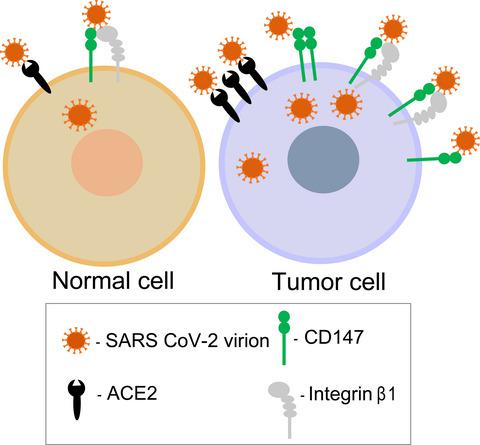Our official English website, www.x-mol.net, welcomes your
feedback! (Note: you will need to create a separate account there.)
Tumor markers as an entry for SARS-CoV-2 infection?
The FEBS Journal ( IF 5.5 ) Pub Date : 2020-08-01 , DOI: 10.1111/febs.15499 Pu Xia 1 , Anna Dubrovska 1, 2, 3, 4, 5
The FEBS Journal ( IF 5.5 ) Pub Date : 2020-08-01 , DOI: 10.1111/febs.15499 Pu Xia 1 , Anna Dubrovska 1, 2, 3, 4, 5
Affiliation

|
Coronavirus disease 2019 (COVID‐19), the highly contagious illness caused by a novel severe acute respiratory syndrome coronavirus 2 (SARS‐CoV‐2), has spread across the globe, becoming one of the most challenging public health crisis of our times. SARS‐CoV‐2 can cause severe disease associated with multiple organ damage. Cancer patients have a higher risk of SARS‐CoV‐2 infection and death. While the virus uses angiotensin‐converting enzyme 2 (ACE2) as the primary entry receptor, the recent experimental and clinical findings suggest that some tumor markers, including CD147 (basigin), can provide an additional entry for SARS‐CoV‐2 infection through binding to the viral spike (S) protein. In the absence of specific viral drugs, blocking of CD147 might be a way to prevent virus invasion. Identifying other target proteins is of high importance as targeting the alternative receptors for SARS‐CoV‐2 might open up a promising avenue for the treatment of COVID‐19 patients, including those who have cancer.
中文翻译:

肿瘤标志物作为 SARS-CoV-2 感染的入口?
由新型严重急性呼吸系统综合症冠状病毒 2 (SARS-CoV-2) 引起的高度传染性疾病 2019 年冠状病毒病 (COVID-19) 已在全球蔓延,成为我们这个时代最具挑战性的公共卫生危机之一。SARS-CoV-2 可引起与多器官损伤相关的严重疾病。癌症患者感染 SARS-CoV-2 和死亡的风险更高。虽然该病毒使用血管紧张素转换酶 2 (ACE2) 作为主要进入受体,但最近的实验和临床发现表明,包括 CD147(basigin)在内的一些肿瘤标志物可以通过结合为 SARS-CoV-2 感染提供额外的进入途径病毒刺突 (S) 蛋白。在没有特定病毒药物的情况下,阻断 CD147 可能是防止病毒入侵的一种方法。
更新日期:2020-09-09
中文翻译:

肿瘤标志物作为 SARS-CoV-2 感染的入口?
由新型严重急性呼吸系统综合症冠状病毒 2 (SARS-CoV-2) 引起的高度传染性疾病 2019 年冠状病毒病 (COVID-19) 已在全球蔓延,成为我们这个时代最具挑战性的公共卫生危机之一。SARS-CoV-2 可引起与多器官损伤相关的严重疾病。癌症患者感染 SARS-CoV-2 和死亡的风险更高。虽然该病毒使用血管紧张素转换酶 2 (ACE2) 作为主要进入受体,但最近的实验和临床发现表明,包括 CD147(basigin)在内的一些肿瘤标志物可以通过结合为 SARS-CoV-2 感染提供额外的进入途径病毒刺突 (S) 蛋白。在没有特定病毒药物的情况下,阻断 CD147 可能是防止病毒入侵的一种方法。











































 京公网安备 11010802027423号
京公网安备 11010802027423号